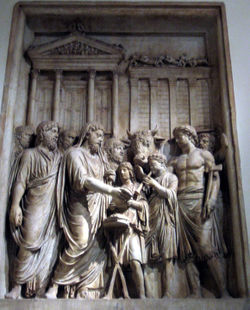Difference between revisions of "Category:Imperial Cult (subject)"
Jump to navigation
Jump to search
(Created page with "'''Imperial Cult''' ==Overview== ==Select Bibliography (articles)== *''' ''' / [[]] / In: The Anchor Bible Dictionary (1992 Freedman), dictionary, *'''Imperial Cult, Jew...") |
|||
| (7 intermediate revisions by the same user not shown) | |||
| Line 1: | Line 1: | ||
'''Imperial Cult''' | [[File:Imperial Cult Marcus Aurelius.jpg|thumb|250px]] | ||
*[[:Category:Topics|BACK TO THE TOPICS--INDEX]] | |||
'''Imperial Cult''' / '''Emperor Cult''' | |||
==Overview== | ==Overview== | ||
== | The Emperor was the head of the Roman States and also the head of the Roman religions (''Pontifex Maximus''), As such he was the symbols of the political and religious identity of the Roman Empire. | ||
The (ethnic, religious, and cultural) diversity of the Roman Empire required a shared authority to keep together all the different components. | |||
==References== | |||
* '''Emperor Cult''' / [[L. Kreitzer]] / [[T&T Clark Encyclopedia of Second Temple Judaism (2020 Stuckenbruck, Gurtner), edited volumes]] | |||
*'''Imperial Cult, Jews and the''' / [[James S. McLaren]] / [[The Eerdmans Dictionary of Early Judaism (2010 Collins / Harlow), dictionary]], 762-763 | |||
*''' ''' / [[]] / [[The Anchor Bible Dictionary (1992 Freedman), dictionary]], | |||
==External links== | |||
[[Category: | [[Category:Index (database)]] | ||
[[Category:Topics]] | [[Category:Topics (database)]] | ||
Latest revision as of 08:27, 14 June 2021
Imperial Cult / Emperor Cult
Overview
The Emperor was the head of the Roman States and also the head of the Roman religions (Pontifex Maximus), As such he was the symbols of the political and religious identity of the Roman Empire.
The (ethnic, religious, and cultural) diversity of the Roman Empire required a shared authority to keep together all the different components.
References
- Emperor Cult / L. Kreitzer / T&T Clark Encyclopedia of Second Temple Judaism (2020 Stuckenbruck, Gurtner), edited volumes
- Imperial Cult, Jews and the / James S. McLaren / The Eerdmans Dictionary of Early Judaism (2010 Collins / Harlow), dictionary, 762-763
External links
Pages in category "Imperial Cult (subject)"
The following 14 pages are in this category, out of 14 total.
1
- Essai sur le culte rendu aux empereurs romains (1890 Beurlier), book
- Le culte impérial: son histoire et son organisation depuis Auguste jusqu'à Justinien (1891 Beurlier), book
- Roman Emperor Worship (1919 Sweet), book
- The Divinity of the Roman Emperor (1931 Taylor), book
- Le culte des souverains dans la civilisation greco-romaine (1957 Cerfaux & Tondriau), book
- Imperial Cult and Honorary Terms in the New Testament (1974 Cuss), book
- Rituals and Power: The Roman Imperial Cult in Asia Minor (1984 Price), book
- Imperial Cult and Commerce in John's Apocalypse (1996 Kraybill), book
- The Imperial Cult and the Development of Church Order (1999 Brent), book
2
- Emperor Worship and Roman Religion (2002 Gradel), book
- Der Kaiserkult in Judäa unter den Herodiern und Römern (2007 Bernett), book
- Paul kwa Roma Cheguk: Roma chegukchuŭi sahoe ŭi chonggyo wa kwŏllyŏk (2007 Horsley / Hong), edited volume (Korean ed.)
- The Purpose of Mark's Gospel: An Early Christian Response to Roman Imperial Propaganda (2008 Winn), book
- Judaism and Imperial Ideology in Late Antiquity (2011 Sivertsev), book
Media in category "Imperial Cult (subject)"
This category contains only the following file.
- 1997-E * Horsley.jpg 907 × 1,360; 161 KB

